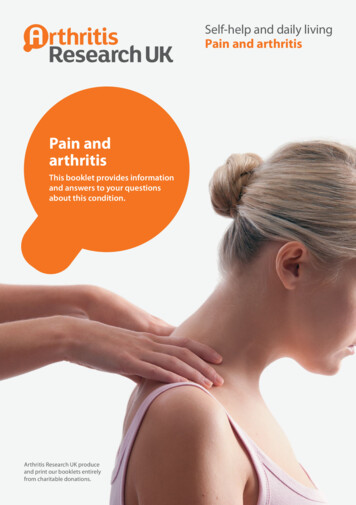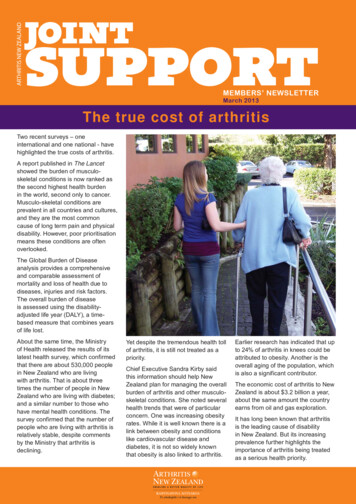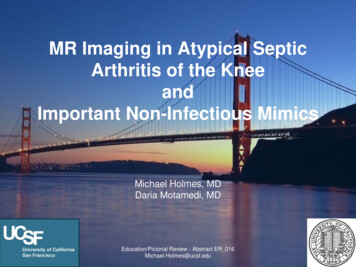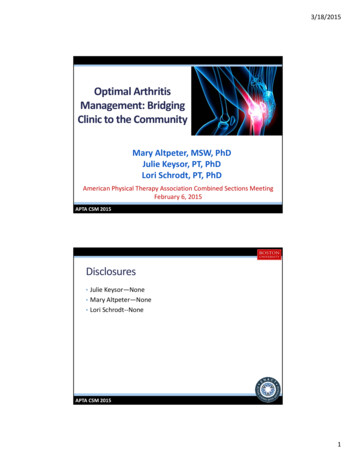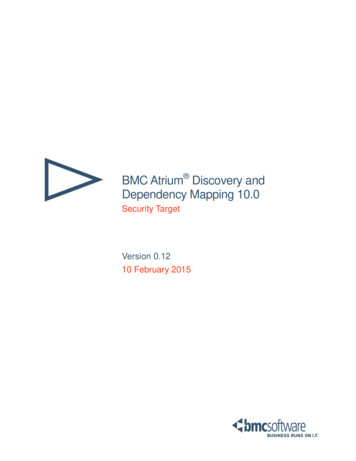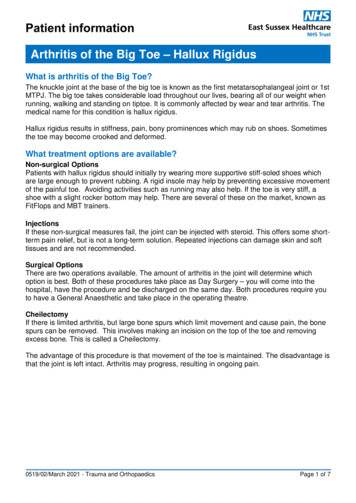
Transcription
Arthritis of the Big Toe – Hallux RigidusWhat is arthritis of the Big Toe?The knuckle joint at the base of the big toe is known as the first metatarsophalangeal joint or 1stMTPJ. The big toe takes considerable load throughout our lives, bearing all of our weight whenrunning, walking and standing on tiptoe. It is commonly affected by wear and tear arthritis. Themedical name for this condition is hallux rigidus.Hallux rigidus results in stiffness, pain, bony prominences which may rub on shoes. Sometimesthe toe may become crooked and deformed.What treatment options are available?Non-surgical OptionsPatients with hallux rigidus should initially try wearing more supportive stiff-soled shoes whichare large enough to prevent rubbing. A rigid insole may help by preventing excessive movementof the painful toe. Avoiding activities such as running may also help. If the toe is very stiff, ashoe with a slight rocker bottom may help. There are several of these on the market, known asFitFlops and MBT trainers.InjectionsIf these non-surgical measures fail, the joint can be injected with steroid. This offers some shortterm pain relief, but is not a long-term solution. Repeated injections can damage skin and softtissues and are not recommended.Surgical OptionsThere are two operations available. The amount of arthritis in the joint will determine whichoption is best. Both of these procedures take place as Day Surgery – you will come into thehospital, have the procedure and be discharged on the same day. Both procedures require youto have a General Anaesthetic and take place in the operating theatre.CheilectomyIf there is limited arthritis, but large bone spurs which limit movement and cause pain, the bonespurs can be removed. This involves making an incision on the top of the toe and removingexcess bone. This is called a Cheilectomy.The advantage of this procedure is that movement of the toe is maintained. The disadvantage isthat the joint is left intact. Arthritis may progress, resulting in ongoing pain.0519/02/March 2021 - Trauma and OrthopaedicsPage 1 of 7
What are the potential risks and side effects of a Cheilectomy?The main complication is ongoing stiffness. Manipulation of the joint is usually successful intreating this. You may need physiotherapy. The joint will have been left intact, and sometimesarthritis can progress, resulting in ongoing pain. If this is the case, a future fusion may berequired. Infection, nerve injury and blood clots are other potential risks. The ‘Preparing forFoot Surgery’ booklet has more information.Recovering from a CheilectomyAfter the operation, the toe is protected with a bandage. This should be left undisturbed andkept dry until you are seen in clinic at two weeks. At this stage, if the wound has healed, it isvery important to get the toe moving. It will be sore at first, but gentle movement will prevent thetoe from becoming stiff. You will be able to fully weight bear, although it will be swollen and sorefor several weeks. Keeping the foot elevated is the best way to reduce this.When can I return to work?You should be able to return to work after two weeks for office-based work. If you have to standfor long periods or wear work boots you may need up to six weeks off.When can I return to driving?Most people are able to return to driving after four weeks, although this can be longer in somecases. You must make sure you are in full control of the car before you drive as your insurancemay be invalid if you drive when impaired.First MTPJ Fusion – why may this be done?If the entire joint is affected with arthritis or the toe is bent, the joint may be surgically fused.The commonest reason for fusing the great toe is arthritis of the great toe joint. This may beisolated arthritis of the great toe (“hallux rigidus”) or part of a generalised arthritis of the foot(usually rheumatoid arthritis). It would only be done if the arthritis has severely damaged thejoint. Sometimes it is difficult to tell from the X-ray whether a cheilectomy (removing excessbone) or a fusion will be required. In this case the surgeon may ask you to allow the decision toPage 2 of 7
be made after the inside of the joint has been inspected during the operation. This would befully discussed with you beforehand.The toe may also be fused to correct a severe deformity of the toe, usually a bunion (“halluxvalgus”). This may seem a very aggressive way to treat a deformity, but severe deformities tendto recur if any lesser form of treatment is used, and a fusion will virtually guarantee this will nothappen.Finally, a fusion may be used to treat problems after failure of another operation on the greattoe, especially if the toe is deformed, weak, floppy or painful. If the toe has been left very shortby the previous operation, a piece of bone may be inserted into the fusion to lengthen the toe.A fusion makes your great toe quite stiff. In particular, it will limit the height of heel you can wearon your shoes. We can allow for a certain amount of heel, but usually not more than 2.5cm (1inch). In addition, the stiff joint may alter the way you walk. Most people do not find this much ofa problem (in fact, if you have severe arthritis, getting rid of the pain by a fusion will usuallymake walking so much more comfortable that the stiffness is a small price to pay).Nevertheless, a few people have to use an insole in their shoes or have alterations to theirshoes. If you cannot accept these limitations, you should not have a fusion.First MTPJ fusion – what does the operation involve?A cut is made over the top of the toe and the joint is opened. Any large bony lumps are trimmed.(The only exception to this is if you have a severe bunion: in this case part of the bunion lumpmay be kept to give a grip to the fixation screws). The joint surfaces are cut out, trimmed toenable the toe to sit in the right position, and fixed together with one or two screws, screws,staples or a metal plate. The wound is stitched up.If you are having a piece of bone put in for a short floppy toe after previous failed surgery, thebone will be removed from the brim of your pelvis just above the hip. It will be fixed into placeusing a small plate as well as screws or pins.The objective is to achieve solid bone healing so that there is no movement across the joint.This eliminates pain and corrects deformity. The disadvantage is that there will be no movementat the joint which will make wearing very high-heeled shoes impossible. Running long distancesmay be difficult.Page 3 of 7
Can it be done as a day case operation?The operation can be done on a day case basis if you are medically fit, have someone who cancollect you and look after you after the operation, and you are comfortable afterwards. Thecommonest reason for having to stay overnight after great toe fusion is for pain control, as theoperation involves cutting through a bone. This may therefore be quite painful immediatelyafterward. Local anaesthetic injections can help with this.Will I have to go to sleep (general anaesthetic)?The operation is usually done under general anaesthetic (asleep). Discussion with youranaesthetist on the morning of surgery will confirm this.In addition, local anaesthetic may be injection into your leg or foot while you are asleep toreduce the pain after the operation even if you go to sleep for the surgery. You will also be givenpain-killing tablets as required.Will I have a plaster on afterwards?You will either be in a plaster bootie for six to eight weeks or you will be fitted with a stiffsoled shoe which allows you to bear weight through your heel but not the front of your foot. Thisprotects the bone whilst it heals.What will happen afterwards?You can go home when comfortable and safe. If you have a plaster, you can walk on the heel ofthis when it is dry, after 48 hours.Dressings should be undisturbed and kept dry for the first two weeks until you are seen in clinic.You will be seen in clinic 10 to 14 days after your operation. The wound will be examined andthe stitches removed if necessary. A full plaster will then be applied or you will retain the specialshoe for at least six weeks. Your foot will be swollen and must be elevated most of the time.Another clinic appointment will be made five to six weeks later. The toe will be examined andanother X-ray taken to assess whether the bone has healed. You can return to normal footwearat this stage, although your foot may be swollen for up to six months. Broad supportive flatshoes are best.Page 4 of 7
How soon can I? Walk on the foot?You can do so immediately, but you should put most of your weight on the heel. You canusually walk fully on the foot after the six week Xray.Go back to work?This depends on what you do and how you get to work. If you have a sitting-down job that youcould do with your foot in bandages, and you can get to work, you could probably go back towork a few days after surgery.On the other hand, if you have a heavy manual job you may be off for up to three months. If youneed to drive to work, this will affect when you can go back. Please discuss this with yoursurgeon.Drive?If your right foot is operated on and you have a manual car, you must not drive while in a plasteror special shoe which you will have for about six weeks. After this, you must be comfortable andnot too stiff before trying to drive. Start by sitting in the car and trying the pedals then driveround the block.Drive short distances before long ones. Remember, if you cannot safely make an emergencystop your insurance will not cover you in the event of an accident.Play sport?After six weeks, you can start gently exercising your foot and walking further each day. Whenyou are comfortable doing this, you can start gentle running and stretching. Contact, twistingand impact sports can follow as comfort dictates. Everyone is different in how quickly they cantake up exercise again, be guided by your own body’s reactions and the advice of your surgeon.Obviously, the stiffness of your toe may affect your ability to play sport, but most people canrun, swim and cycle as much as they were doing beforehand within six months of surgery.What are the potential risks and side effects?The most serious problem after a fusion is failure of the joint to fuse. This occurs in about 10%of people. Half of these will have no problems from their unfused joint, as the scar created bysurgery holds the bones together as firmly as a proper fusion. However, most of the rest willneed to have the operation done again. If you are having a re-fusion, lengthening fusion orfusion for previous failed surgery the rate of failure is higher at 15 to 20% and again about halfwill be painful. Diabetes, rheumatoid arthritis, poor circulation and smoking also increase therisk of failure.If you smoke, you must stop before surgery. There is help to do this at https://smokefree.gov.When the joint is fused, the toe will be slightly shorter afterwards. This is normal.Occasionally the screws, staples or plate may be felt under the skin when the swelling hassubsided. If this causes irritation they can be removed after six months.It is important to prepare for an operation to reduce the risks of complications. There isinformation about how to do this at: https://www.cpoc.org.uk/patients.Page 5 of 7
1.SwellingThe foot tends to swell up quite a lot after surgery. Swelling is part of your body’s naturalresponse to any injury and surgery is no exception. In addition, your foot is at the bottom ofyour body so fluid tends to collect in its tissues (“at the bottom of the slope”) and causeswelling. People vary in how quickly this swelling disappears after an operation. Providedyou are not having undue pain or inflammation you can afford to give it time. Try to elevatethe foot on pillows between bouts of activity.2.PainIf you need to have a bone graft taken from your pelvis, this is often quite painful for acouple of weeks and some people have a little numb area beneath the scar. Again, this isnormal but can be irritating. If you are concerned contact your surgeon for further advice.3.InfectionInfections in the wound, plaster problems and minor damage to the nerves of the toe canoccur in any foot surgery. Usually these are minor problems that get better quickly. Rarely,the fusion itself becomes infected. This would require a further operation to clear theinfection, antibiotics, and usually a repeat fusion when the infection has settled.There are risks of infection, nerve injury, blood clots and ongoing pain. The ‘Preparing for FootSurgery’ booklet has more information.A note on Joint ReplacementIn the past, surgeons have tried replacing the first MTPJ with an artificial joint. The results havegenerally been poor. The artificial joint wears quickly and can come loose, resulting inrecurrence of pain and deformity. Correction is difficult and often unsuccessful. Currently we donot recommend this treatment for most patients.Who should I contact if I have a problem after the surgery?You will have clinic appointments two and six weeks after the operation. It is often helpful towrite any questions down beforehand so you don’t forget them.If you have a problem at any other time, please contact the Day Surgery Unit, the CastingDepartment or your Consultant’s secretary via the hospital SwitchboardConquest Hospital - Tel: 0300 131 4500Eastbourne DGH – Tel: 0300 131 4500In an emergency contact your GP or attend the Emergency Department (A&E).ConsentAlthough you consent for this treatment, you may at any time after that withdraw such consent.Please discuss this with your medical team.Sources of informationFor more information you can visit the NHS Choices website duction.aspxor Versus Arthritis website – https://www.versusarthritis.org/Page 6 of 7
Important informationThe information in this leaflet is for guidance purposes only and is not provided to replaceprofessional clinical advice from a qualified practitioner.Your commentsWe are always interested to hear your views about our leaflets. If you have any comments,please contact the Patient Experience Team on 0300 131 4731 (direct dial) or by email at: eshtr.patientexperience@nhs.netHand hygieneThe trust is committed to maintaining a clean, safe environment. Hand hygiene is very importantin controlling infection. Alcohol gel is widely available at the patient bedside for staff use and atthe entrance of each clinical area for visitors to clean their hands before and after entering.Other formatsIf you require any of the Trust leaflets in alternative formats, such as largeprint or alternative languages, please contact the Equality and HumanRights Department.Tel: 0300 131 4434 Email: esh-tr.AccessibleInformation@nhs.netAfter reading this information are there any questions you would like to ask? Please list belowand ask your nurse, doctor or practitioner.ReferenceWritten by:Mr Henry Willmott – Consultant Orthopaedic SurgeonMr Andrew Skyrme – Consultant Orthopaedic SurgeonMrs Scarlett McNally – Consultant Orthopaedic SurgeonThe following clinicians have been consulted and agreed this patient information:Mr Michael Dunning – Consultant Orthopaedic SurgeonThe directorate group that have agreed this patient information leaflet:Trauma and OrthopaedicsNext review date:Responsible clinician:March 2024Henry Willmott – Consultant Orthopaedic Surgeon andOrthopaedic Research Unit East Sussex Healthcare NHS Trust – www.esht.nhs.ukPage 7 of 7
The commonest reason for fusing the great toe is arthritis of the great toe joint. This may be isolated arthritis of the great toe ("hallux rigidus") or part of a generalised arthritis of the foot (usually rheumatoid arthritis). It would only be done if the arthritis has severely damaged the joint.



